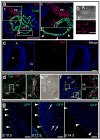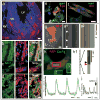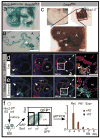Epicardial progenitors contribute to the cardiomyocyte lineage in the developing heart
- PMID: 18568026
- PMCID: PMC2574791
- DOI: 10.1038/nature07060
Epicardial progenitors contribute to the cardiomyocyte lineage in the developing heart
Abstract
The heart is formed from cardiogenic progenitors expressing the transcription factors Nkx2-5 and Isl1 (refs 1 and 2). These multipotent progenitors give rise to cardiomyocyte, smooth muscle and endothelial cells, the major lineages of the mature heart. Here we identify a novel cardiogenic precursor marked by expression of the transcription factor Wt1 and located within the epicardium-an epithelial sheet overlying the heart. During normal murine heart development, a subset of these Wt1(+) precursors differentiated into fully functional cardiomyocytes. Wt1(+) proepicardial cells arose from progenitors that express Nkx2-5 and Isl1, suggesting that they share a developmental origin with multipotent Nkx2-5(+) and Isl1(+) progenitors. These results identify Wt1(+) epicardial cells as previously unrecognized cardiomyocyte progenitors, and lay the foundation for future efforts to harness the cardiogenic potential of these progenitors for cardiac regeneration and repair.
Figures




References
-
- Martin-Puig S, Wang Z, Chien KR. Lives of a heart cell: tracing the origins of cardiac progenitors. Cell Stem Cell. 2008;2:320–331. - PubMed
-
- Laugwitz KL, Moretti A, Caron L, Nakano A, Chien KR. Islet1 cardiovascular progenitors: a single source for heart lineages? Development. 2008;135:193–205. - PubMed
-
- Moretti A, et al. Multipotent embryonic isl1+ progenitor cells lead to cardiac, smooth muscle, and endothelial cell diversification. Cell. 2006;127:1151–1165. - PubMed
-
- Wu SM, et al. Developmental origin of a bipotential myocardial and smooth muscle cell precursor in the mammalian heart. Cell. 2006;127:1137–1150. - PubMed
-
- Manner J, Perez-Pomares JM, Macias D, Munoz-Chapuli R. The origin, formation and developmental significance of the epicardium: a review. Cells Tissues Organs. 2001;169:89–103. - PubMed
Publication types
MeSH terms
Substances
Grants and funding
LinkOut - more resources
Full Text Sources
Other Literature Sources
Medical
Molecular Biology Databases

